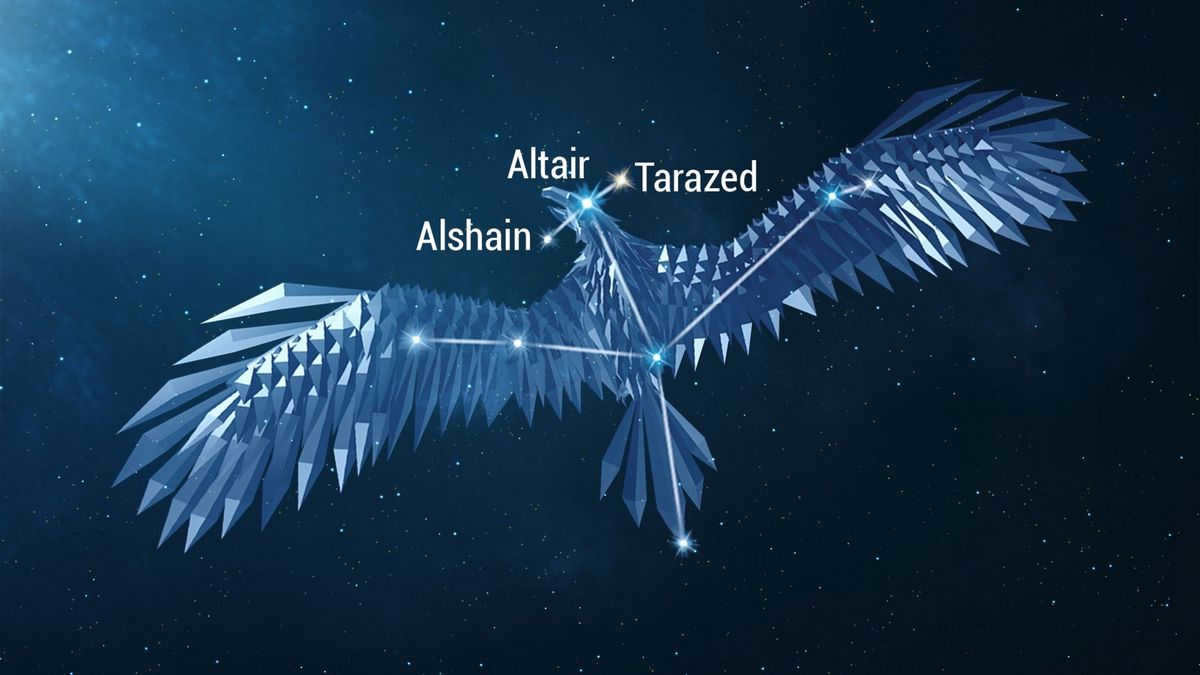
In the night sky, you can spot the constellation of Eagle, also known as Aquila in Latin. Eagle is among the most ancient constellations that mankind has been aware of.
Locating the constellation
Eagle can be found in close proximity to the celestial equator, making it easier to observe from southern latitudes. It is most prominently visible in the temperate region from June to September, with August being the ideal time for observation. On a clear night, you can witness up to 70 stars. The brightest star in the Eagle constellation is Altair, also known as the “flying eagle.” By connecting the 10-11 most visible stars in a particular pattern, you can outline the shape of a soaring eagle.
Three Aquila stars – Alshain, Altair, and Tarazed – are positioned next to each other, forming an asterism known as the “box of scales.” This formation is easily distinguishable in the summer sky.
Description
The Eagle constellation covers an expansive area of 652 square degrees, placing it in the 22nd position out of the 88 identified constellations. Aquila is surrounded by several neighboring constellations, including Arrow to the north, Hercules and Serpentor to the east, Capricorn, Sagittarius, and Shield to the south, and Dolphin and Aquarius to the west.
Triangle in the sky during summer and fall
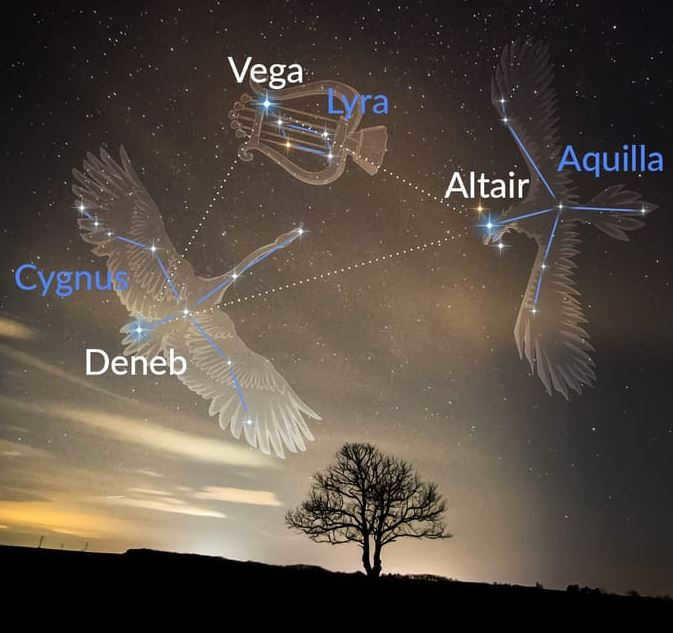
The Triangle asterism was utilized as a navigational guide, providing orientation for ships and explorers. When observing the nocturnal sky while facing towards the south, one can observe a trio of stars.
Vega, belonging to the constellation Lyra, Deneb, from the constellation Swan, and Altair. These three celestial bodies combine to form a triangular shape. Vega stands out as the most luminous star, while Altair, the second brightest, resides in closest proximity to Earth.
Deneb appears comparatively less radiant than its “companions”. However, it is in fact a supergiant, emitting light that is 200,000 times more powerful than that of the Sun. Furthermore, it is positioned at a distance of 1,467 light-years from our planet.
Mythology
As early as 5,000 years ago, the Sumerians referred to this group of stars as the constellation Eagle.
In the ancient Greek myths, the Eagle played a crucial role in serving Zeus and carrying out his tasks. It was this very bird that relentlessly pecked at Prometheus’ liver while he remained chained to a rock. Moreover, it was also responsible for abducting Ganymede and delivering him to Zeus to serve in his court. Recognizing the bird’s exceptional contributions, Zeus elevated it to the heavens, transforming it into a constellation.
Stellar Objects
In his catalog Almagest, Claudius Ptolemy documented a total of 15 stars attributed to the constellation known as the Eagle. However, Jan Hevelius depicted a greater number of stars, specifically 22, in his celestial atlas called “Uranographia”. Currently, the Eagle constellation boasts an impressive count of 135 luminous celestial bodies.
Altair, the Primary Star of the Eagle
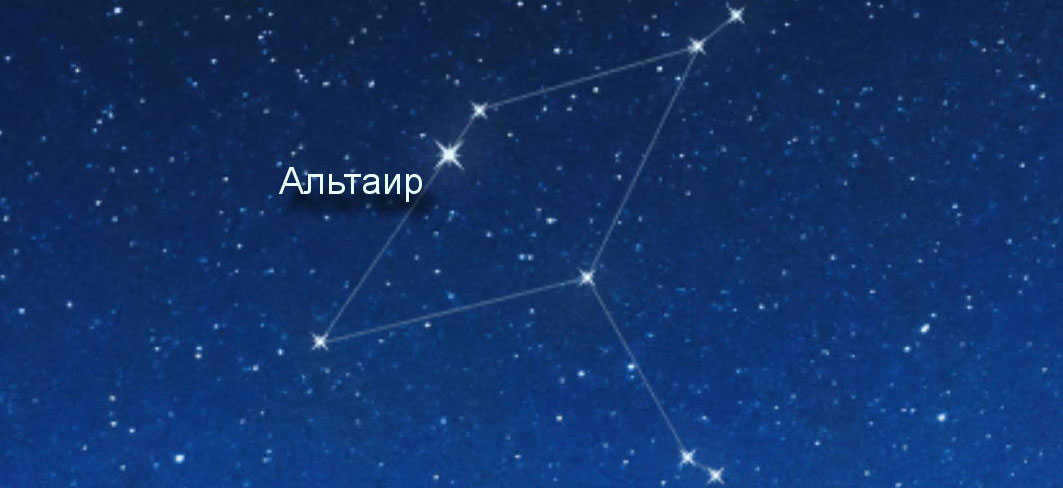
Altair, which is the most prominent star in its constellation and the 12th most visible in the sky, is classified as an A7 V star. It has a stellar magnitude of 0.77 m. The mass of Altair is 1.76 times that of the Sun, while its estimated radius is between 1.63 and 2.3 times that of our star. The surface temperature of Altair ranges from 6900K to 8500K. Notably, Altair is 10.7 times brighter than the Sun.
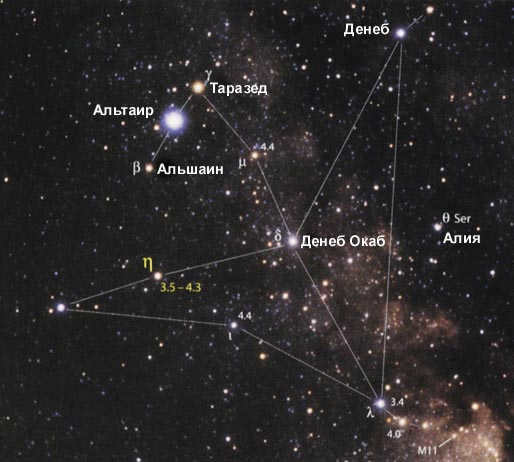
Altair is situated in the constellation Eagle and is positioned at a distance of 16.8 light years from Earth, making it one of the closest stars to our planet. This star is classified as a white main-sequence star and is still undergoing hydrogen fusion in its core.
Altair is known for its rapid rotation, which results in a noticeable flattening at its poles. It completes one revolution in approximately 10 hours, while its equator reaches a speed of 286 kilometers per second.
Comparatively, Jupiter also has a 10-hour rotation period, but its equator only travels at a speed of 13 km/s.
In close proximity to Altair are Tarazet and Alshain, which form a straight line and are often depicted as the neck of the Eagle.
In the years 2006-2007, a remarkable achievement was made by astronomers who managed to capture an extraordinary image of Altair’s surface. This groundbreaking image had an incredibly high resolution, measuring less than one angular millisecond. Upon closer examination, the images revealed fascinating variations in the brightness of the photosphere based on latitude. Additionally, distinct areas of both light and dark spots were observed, further adding to the intrigue surrounding Altair.
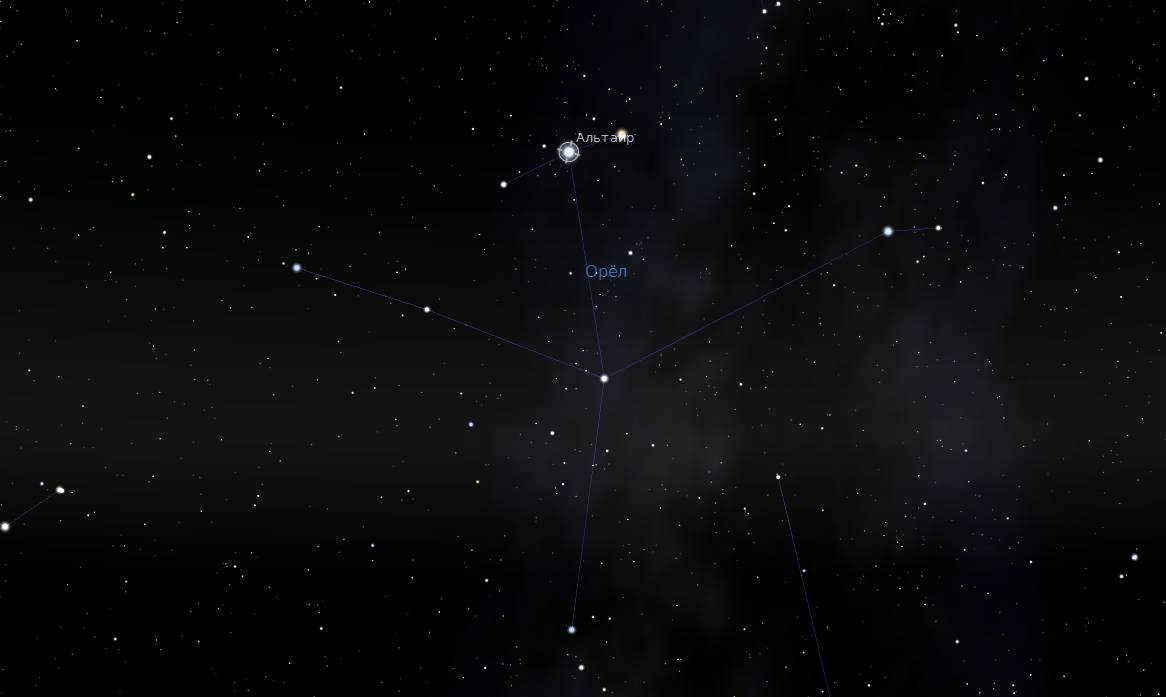
Altair belongs to the Delta Shield class of variable stars and its brightness remains almost constant. It emits weak X-ray radiation, with the most active sources found near its equator. Researchers hypothesize that this phenomenon is caused by the movement of convection cells from the hotter polar areas to the cooler equatorial regions.
The high rotation speed of Altair leads to gravitational darkening, with the poles appearing brighter than the equator.
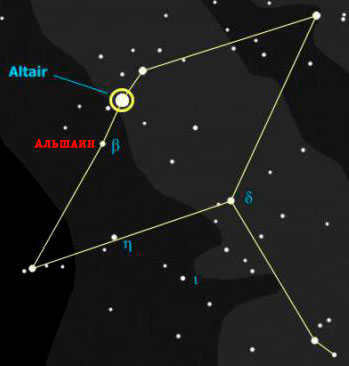
Alshain is the seventh brightest star in the constellation Orla. The name Alshain translates to “hunting falcon”. In Johann Bayer’s star catalog published in 1603, Alshain was given the name Beta of Eagle. However, stars are typically classified based on their decreasing brightness.
Alshain is classified as a subgiant star of class G8 IV. It is located at a distance of 44.7 light-years away. The apparent stellar magnitude of Alshain is 3.7 m. Beta is currently in the stage of becoming a red giant.
Alshain is actually a triple star system. Beta B of Eagle is a red dwarf star belonging to class MIII. The mass of the second star is approximately equal to that of the Sun, and its radius is 4.7 times smaller than that of our Sun. Its stellar magnitude is only 11.4 m.
Bezeq, Aeta.
Reportedly, Bezeq is a stellar system consisting of three stars that is located 1382 sv years away from our position. In terms of its visual appearance in the night sky, Eta Eagle can be observed to the south of Altair.
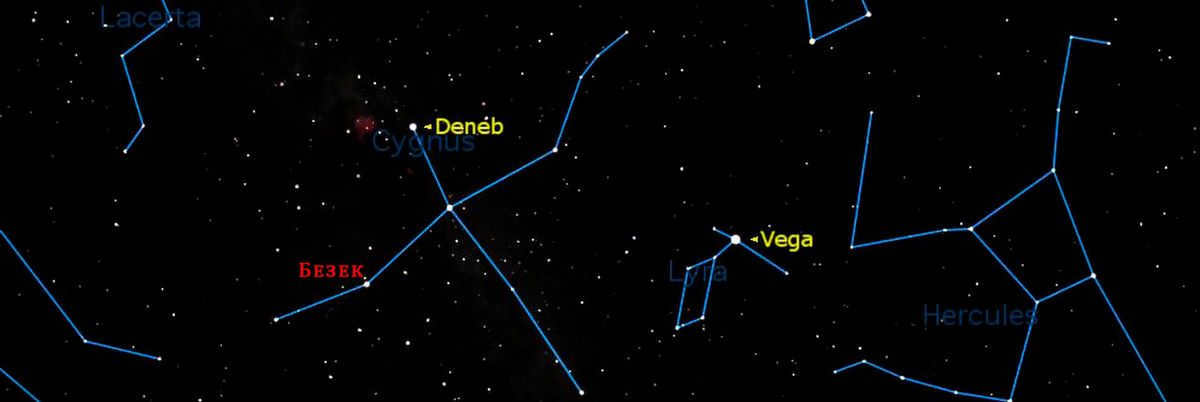
The primary star in the Eta A system is believed to be classified as B8.9. It has an apparent magnitude of 3.87 m. This star is a Cepheid variable, meaning its luminosity varies between 3.48 and 4.4 over a period of 7 days. It is part of the Cepheid variable family, and its luminosity changes from 3.48 to 4.4 every 7 days. It has a radius 51 times that of the Sun and a mass 11.5 times that of the Sun.
The Eta B satellite is classified as spectral class F. The characteristics of the third component of the system are still not well understood.
Tarazet, Gamma
Tarazet, Gamma
is a unique text that needs to be paraphrased.
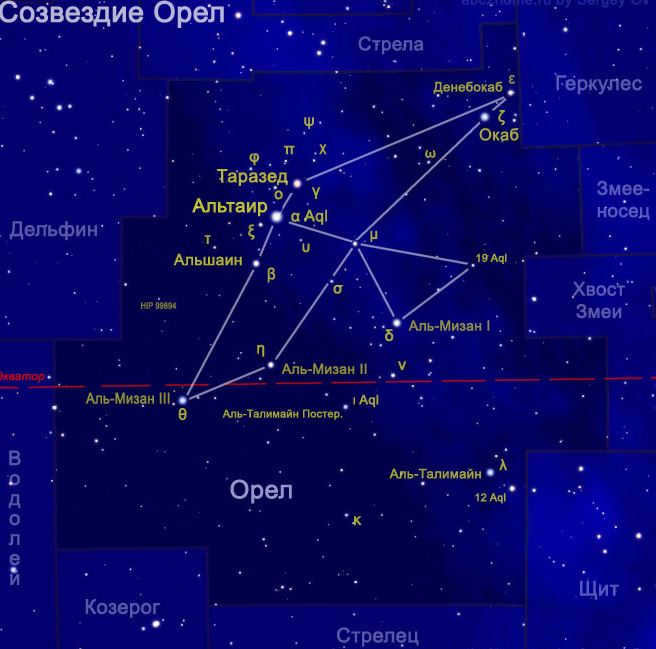
The star Tarazed, also known as Tarazet, Gamma Eagle, can be seen with the naked eye and is located a few degrees north of Altair. It is particularly visible from late June to November. The Arabic name Tarazed translates to “shoulder of balance” or “ray”.
Tarazed is a binary star system, consisting of a orange giant KIII star called Gamma A and a yellow dwarf star called Gamma B. These two stars are located 395 light-years or 121 parsecs away from the Sun.
Visually, Gamma A and Gamma B appear to be separated by 133 angular seconds, although the actual distance between them may be closer to one light-year. Gamma A has a mass of 5.7 solar masses and a radius that is 95 times larger than the radius of the Sun. It has an apparent magnitude of 2.7.
Gamma A has a surface temperature of 4200K and its luminosity is 2500 times greater than that of the Sun. In 1991, there was an observation indicating a change in the brightness of this star. Tarazet A, which is 100 million years old, has already consumed all of its hydrogen and now it continues to burn helium to carbon.
On the other hand, Gamma B is similar to the Sun in terms of mass and radius. It has a surface temperature of approximately 5000K and its luminosity is only 10% lower than that of the Sun. The visible magnitude of Gamma B is recorded as 10.7 m.
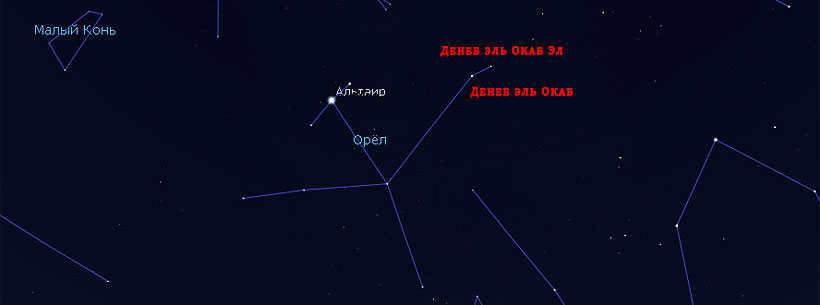
Deneb el Okab El, Epsilon.
Epsilon can be found near Zeta, bordering the Hercules constellation. This star is not as easily visible as its “neighbor”. It has an apparent magnitude of 4.02 m. The distance from our solar system’s center is approximately 136 light years. Deneb el Okab El is classified as a K1-IIICN star. It is actually a binary star system. Epsilon A has a mass twice that of the Sun and a radius ten times that of the Sun. Its luminosity is 54 times brighter than our own star. Epsilon B has a mass similar to that of our Sun.
Deneb el Okab, Zeta.
Deneb el Okab is a binary star system. The name translates as “eagle’s tail”, although in modern star charts, the star is depicted as the upper wing edge of the constellation when viewed from northern latitudes. Its apparent magnitude is approximately 3 m, and it is located 83 light-years away. Zeta has a radius 2.3 times that of the Sun and a mass 2.4 times that of the Sun.
The epsilon star of the constellation Eagle is also known as Deneb el-Okab Borealis because it is positioned to the north, unlike Zeta, which can be referred to as Deneb el-Okab Australis.
The Eagle constellation is home to a wide variety of celestial objects in the vast expanse of deep space. Within this region, you can find an array of globular and scattered clusters of stars, quasars, galaxies, pulsars, as well as planetary and dark nebulae that are visible to the naked eye.
NGC 6781
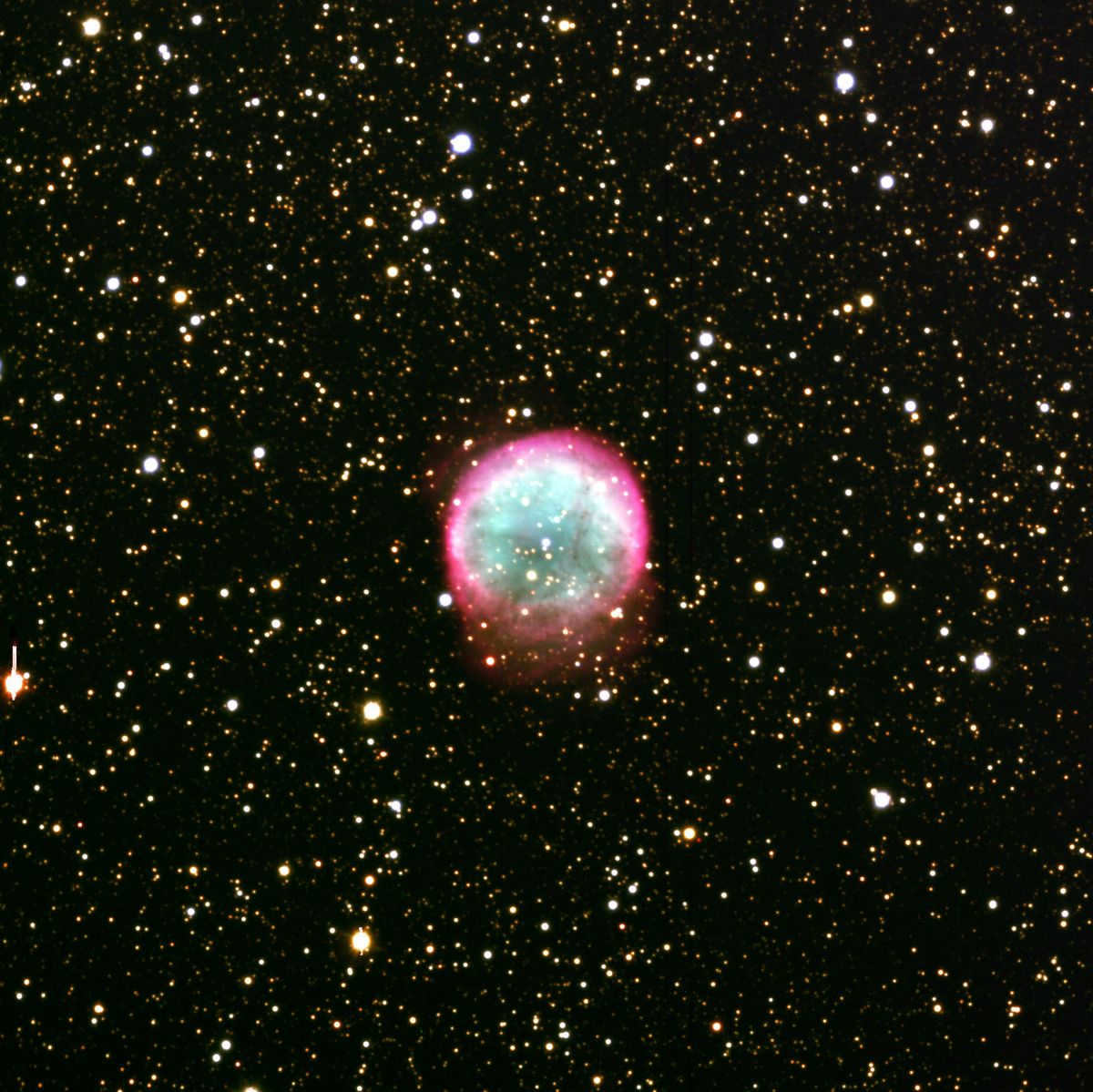
William Herschel is credited with the discovery of the nebula NGC 6781 or PK 41-2.1. It was in 1788 that he first observed a peculiar barrel-shaped object through his telescope. Subsequent research has shown that the nebula is oriented in such a way that one of its poles is facing towards us. The nebula’s outer layer is composed of carbon dust. Its apparent magnitude, a measure of its brightness as seen from Earth, is 11.4 m.
NGC 6803
can be rephrased as “The astronomical object designated as NGC 6803” or “NGC 6803, also known as”
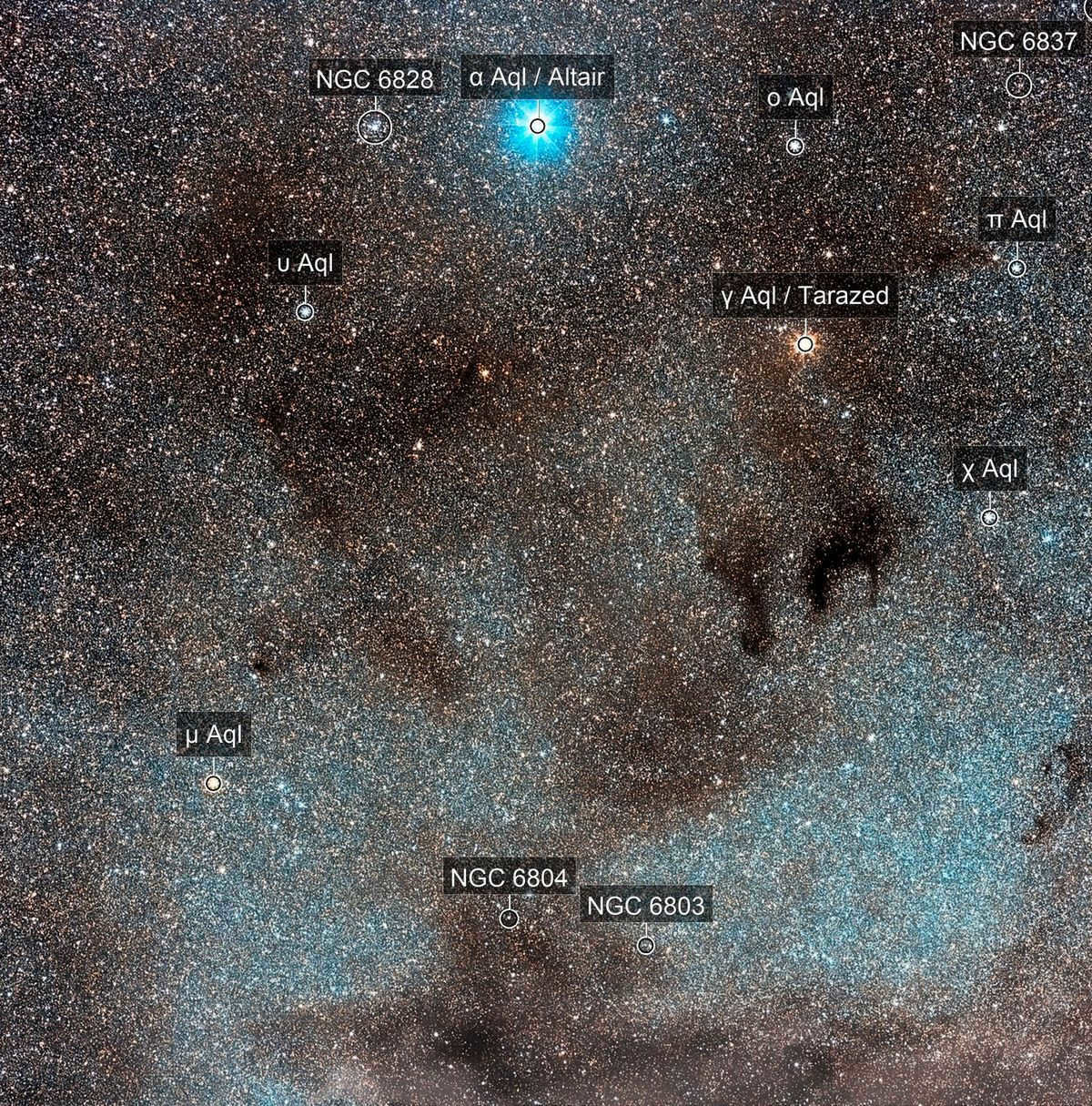
The constellation Eagle, also known as Aquila, is where NGC 6803 or PK 46-4.1 can be found. It is situated 4° west of Tarazed, which is the Gamma star in the Eagle constellation. NGC 6803 was first discovered by E. Pickering in September 1883. This planetary nebula has an apparent magnitude of 11.4m and is approximately 17,200 light-years away from the Sun.
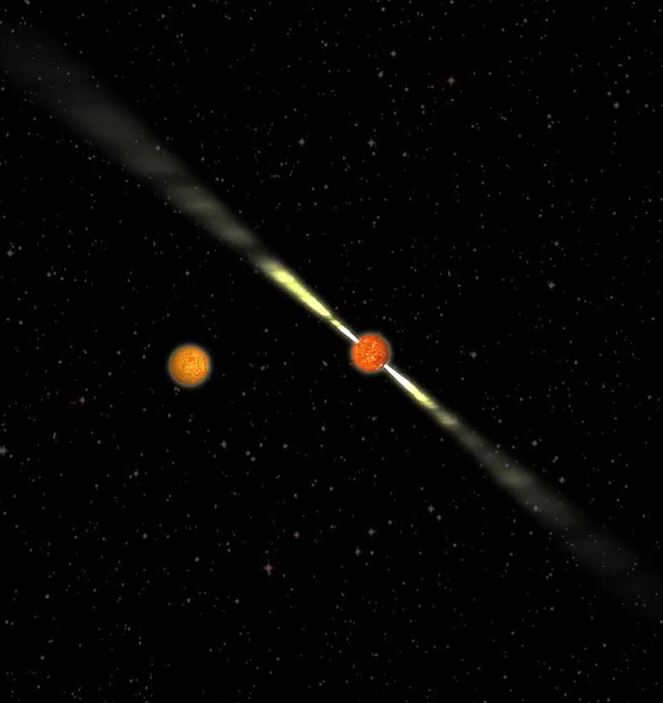
The PSR J1906+0746 pulsar, known as the double pulsar, was first detected in 2004 by a group of researchers at the Arecibo Observatory in Puerto Rico. This unique celestial object is situated south of Eagle’s Zeta.
In a binary system, a neutron star revolves around a common center of mass with its companion, which can be a white dwarf or another neutron star. These binary systems occur approximately 60 times per million years. The PSR J1906+0746 pulsar is located 25,000 light-years away from our solar system.
For a period of time, intermittent bursts of radio emissions were observable from Earth until 2010. Currently, the pulsar is no longer visible. Scientists predict that this system will become visible again in the year 2170.
NGC 6804
can be rephrased as “NGC 6804 is a celestial object”.

The NGC 6804 planetary nebula, also known as K 45-4.1, was first observed by W. Herschel in 1791. It is more easily visible in the night sky compared to NGC 6803. This nebula is located approximately 2800 light-years away from Earth. It has an apparent magnitude of 12 m.
NGC 6760: An Object of Interest
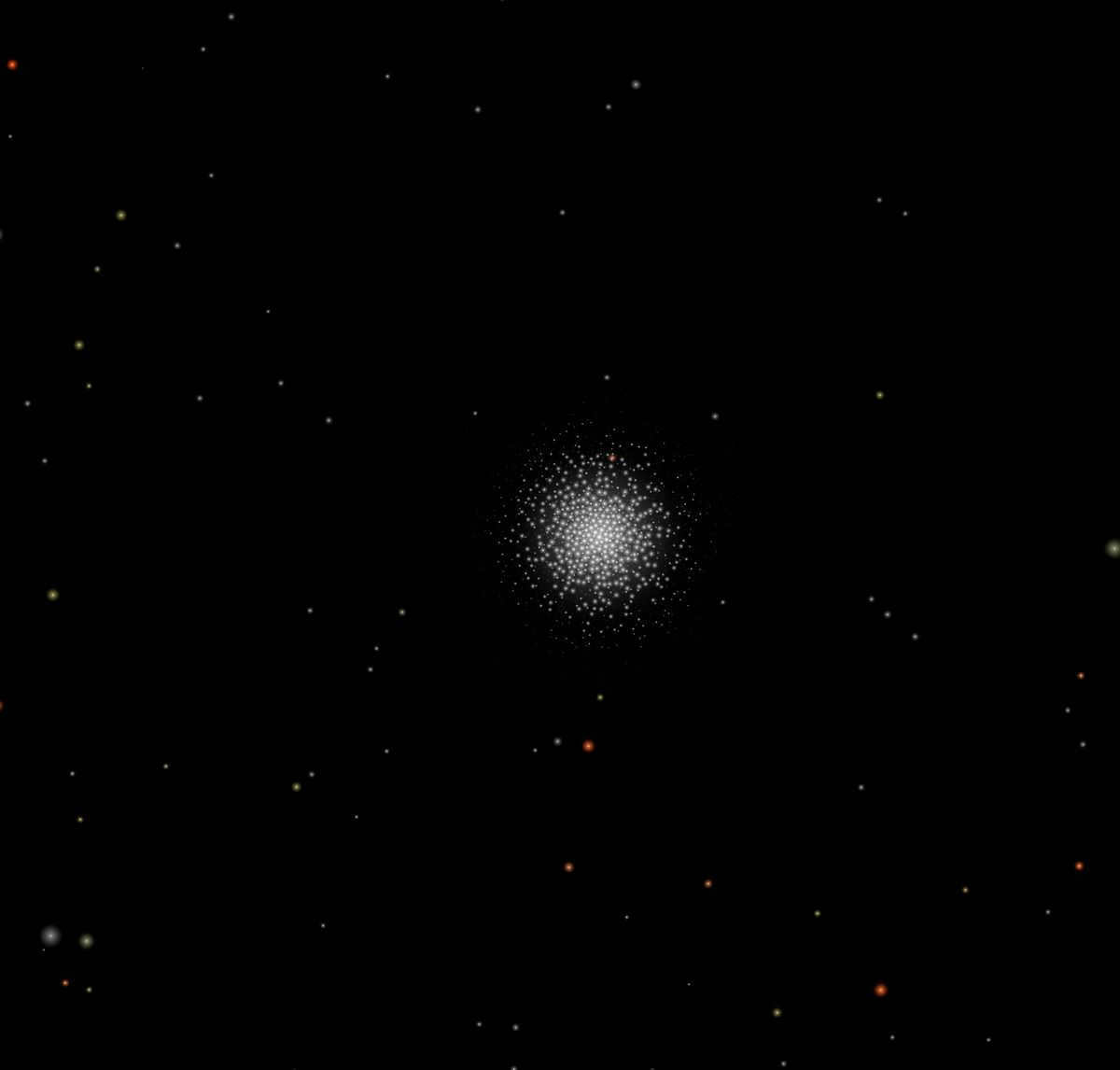
The discovery of this globular cluster dates back to 1845 when it was first identified by the renowned English astronomer, John Haydn. With a stellar magnitude of 9 units, it continues to captivate astronomers and researchers alike.
Barnard Nebulae
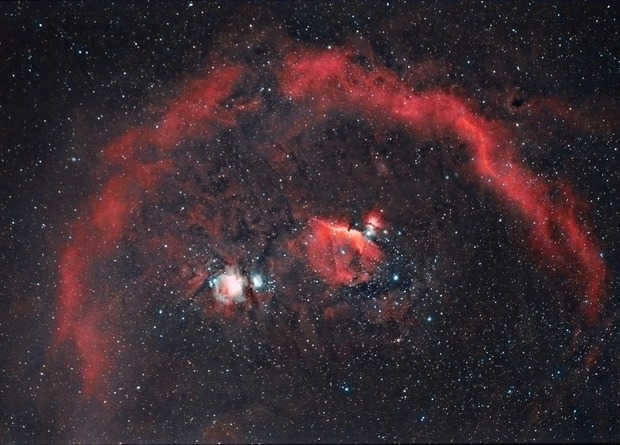
Nebulae 142 and 143 can be found in the northwest region of the Gamma Eagle constellation and can be seen in the night sky with regular binoculars. These nebulae have a unique shape and appear as two distinct spots. They are located approximately 2000 light-years away from our position.
NGC 6751
is a planetary nebula located in the constellation Aquila. It was discovered in 1788 by German-British astronomer Sir William Herschel. This nebula is known for its complex and intricate structure, which is the result of the dying star at its center shedding its outer layers. NGC 6751 is also notable for its bright blue-green color, which is due to the presence of oxygen and other elements in its gas clouds. The nebula is approximately 6,500 light-years away from Earth and has a diameter of about 0.8 light-years.

The PK 29-5 nebula, also known as NGC 6751, is located at a distance of 18,430 light years from our position. It has an apparent stellar magnitude of approximately 12 m.
The Eagle constellation boasts a fascinating history and is home to numerous captivating celestial objects that are yet to be fully explored.
Questions and Answers
In the Milky Way galaxy, there have been 1,100 scattered star clusters discovered so far.
What we see is a shell of ionized gas that forms around a white dwarf star.
While a nebula is composed of gas, dust, and plasma, a cluster is a collection of stars that originate from a single molecular cloud.
NGC stands for New General Catalogue, which is a comprehensive list that includes all known nebulae, galaxies, and star clusters.
A parsec is equivalent to 3.261339 light years.
Scientific Facts: A Visual Overview
In the constellation Eagle lies a fascinating star known as Altair. Not only is it the most luminous in this celestial region, but it also holds the 12th position in terms of brightness among all the stars in the sky.
As previously mentioned, Altair is the designated Alpha star of the Eagle. However, there are other distinguishing features that set it apart from other celestial entities. Let’s delve into these characteristics in the following discussion.

What are the characteristics of Altair?
To begin with, Altair is classified as a main-sequence star. Specifically, it is a variable star of the Beta Shield type and belongs to the A7 V spectral class.
Altair has a mass and radius that are both 1.7 times that of our Sun. However, its luminosity is approximately 11 times greater than that of our Sun. Additionally, it has an apparent magnitude of -0.77 and an absolute magnitude of 2.22.
Interestingly, Altair is one of the closest stars to Earth that is visible to the naked eye. It is located 17 light years away.
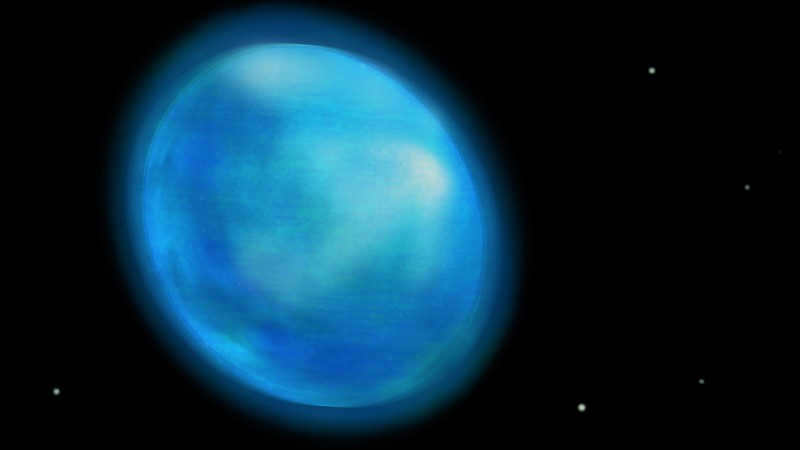
However, it is not just the close proximity of Altair that captures the attention of astronomers. What makes this star particularly fascinating is its surprisingly rapid rotation around its axis. In fact, Altair completes a full revolution with an equatorial speed of 286 km/s in less than 9 hours.
This motion results in the equator of the star having a larger diameter compared to its poles. Additionally, as the radius changes, gravity, temperature, and brightness decrease from the equator to the poles. This phenomenon is known as gravitational darkening.
It is worth mentioning that technological advancements and research have repeatedly confirmed this effect on Altair. Furthermore, images of Altair’s disks have been captured, revealing the flattening effect caused by gravitational darkening.
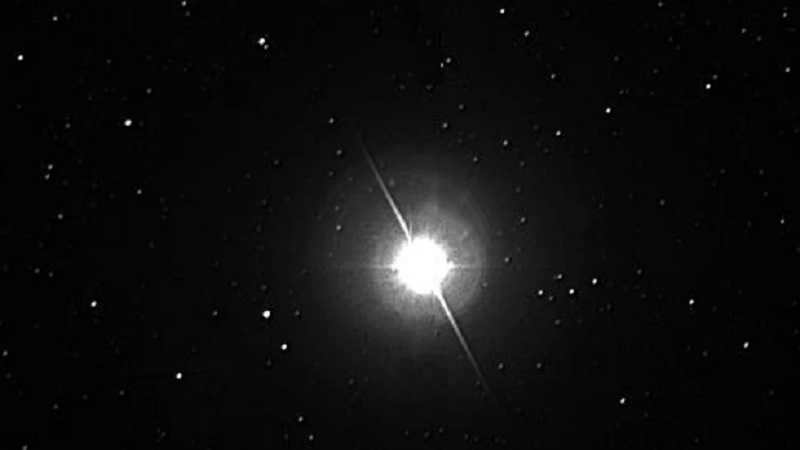
Altair and its significance in astrology
Given that astrology explores the influence and effects of celestial bodies on human life and destiny, let’s delve into the role of our luminary in this field. To be honest, there is a wealth of information available, often with conflicting viewpoints.
Traditionally, Altair is believed to be a stationary star. It is primarily associated with the Fire element, albeit with some minor associations with other elements. Additionally, Altair is linked to the Moon and is said to influence success, courage, and bravery.
Ultimately, the interpretation of Altair’s significance in astrology is subjective and often based on personal beliefs. As the saying goes, “you get what you believe in.”
Did you know?
Did you know that the word “Altair” actually means “soaring eagle” in Arabic?
This star has been known since ancient times and has had other names in the past, such as Ethos and Eagle Star.
Interestingly, Altair emits a small amount of X-ray radiation.
Furthermore, it is part of a group of stars known as the Autumn-Summer Triangle, along with the prominent stars Vega in the Lyra constellation and Deneb in the Swan constellation.
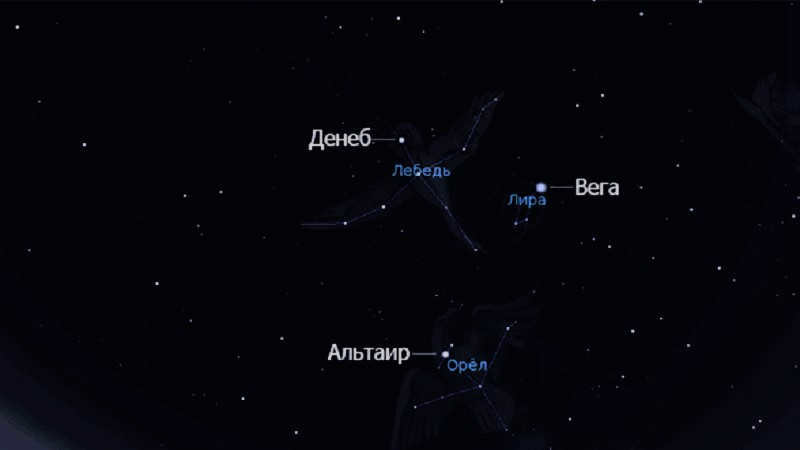
So, we have gathered information about Altair, its characteristics, and its position in the sky. I trust you found it intriguing!
This celestial object takes only 6.5 hours to complete one rotation on its axis. It is 1.5 times larger than the Sun, spins faster than the Earth, and is the nearest star to us (around 17 light years away) that is visible to the naked eye.
What precisely is Altair? In which constellation can it be found? What impact does it have on other planets in astrology? What role does it play in the cultural beliefs of various nations?
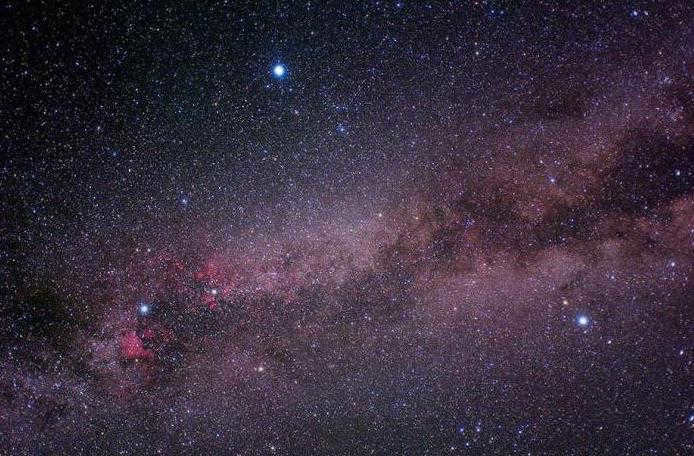
Altair, a star located in the constellation Eagle, is part of a group of stars known as the Summer Triangle, along with Vega in the constellation Lyra and Deneb in the constellation Swan.
Out of the three stars, Vega shines the brightest. Altair comes in second place in terms of brightness. Deneb, on the other hand, appears relatively dim compared to its companions. Despite being three times dimmer than Vega, Deneb is actually one of the largest supergiant stars ever discovered. It shines 80,000 times brighter than the Sun, but due to its distance of 1,467 light-years away from Earth, it appears to be completely devoid of brightness.
The importance of astrology
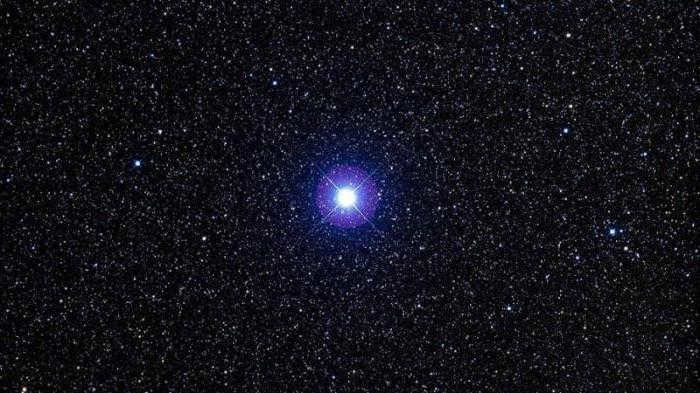
Altair is situated in a specific constellation and possesses the qualities of both Mars and Jupiter. It imparts attributes such as courage, confidence, valor, tenacity, ambition, and the potential for great but temporary wealth. Individuals with this white dwarf present in their horoscope may find themselves involved in acts of violence.
When combined with other favorable celestial influences, Altair brings about endurance, bravery, and honesty. Its presence in a horoscope is particularly beneficial for those in the legal and military professions.
Influence on the planets
- Sun: For those individuals who are under the Sun’s patronage, Altair’s influence signifies the potential for fame, favor from superiors, a large circle of friends, and a small number of envious individuals. However, it is important to be cautious of health issues and unexpected financial losses. Additionally, one should be mindful of the risk of being bitten by poisonous reptiles.
- The Moon: The Moon supports individuals who have an interest in peculiar and ancient discoveries. When influenced by Altair, it suggests the possibility of disappointment, loss of assets, missed opportunities for profit, conflicts with friends, and difficulties related to national affairs. For children, it may bring about challenges and misfortunes.
- Mercury: Altair’s influence on Mercury brings forth numerous challenges, failures, and uncertain experiences. It may lead to disappointment during a long journey and the loss of a loved one under mysterious circumstances.
- Mars: environmental issues that will eventually be resolved safely.
- Jupiter: genuine or pretended religious passion, hypocrisy, concerns about legal and religious matters, dissatisfaction with inheritance.
- Saturn: sadness and disappointment; mental illnesses that require medication; possibility of death due to mental disorders; separation from family and parents; risk of accidents leading to disability.
- Neptune: excessive sensitivity, mystical occurrences, hidden enemies, lack of harmony at home, unexpected death.
Significance in mythologies of the past
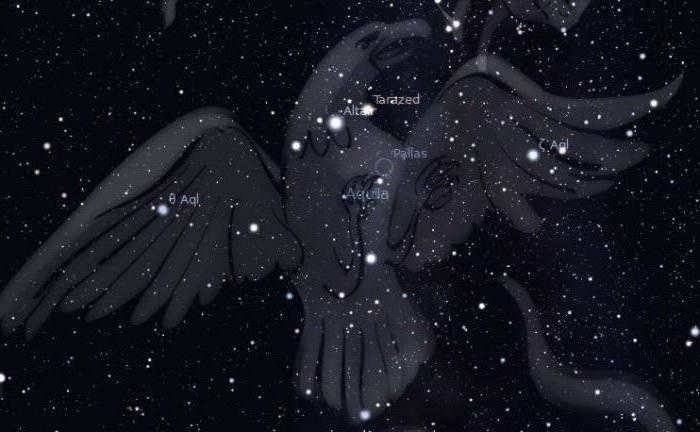
The name “An-nasr at-tair” is an Arabic translation of “soaring eagle”.
In ancient mythology, the Eagle was a trusted companion of Zeus, playing a significant role in numerous stories. In one tale, the Eagle was responsible for abducting the beautiful young man Ganymede and bringing him to Olympus to serve as a cupbearer during the gods’ festivities. In another legend, the Eagle relentlessly tortured Prometheus by pecking at his liver day after day, ultimately meeting its demise at the hands of Heracles.
The era of the ancient gods has long passed, and the Arabic name has been simplified to Altair – a star that, much like the bird that served Zeus, fulfills its crucial role.
Interpretation within Asian legends

In Japan, there exists a tale regarding a youthful shepherd named Hikoboshi, who became infatuated with the celestial weaver known as Orihime (or Tanabata).
Each day, Orihime diligently weaved the fabric of the heavens, but upon meeting Hikoboshi, she fell head over heels in love, completely forgetting her duties. This enraged the Goddess of Heaven (or in some versions, the girl’s parents), who separated the two lovers by the Heavenly River (also known as the Milky Way), prohibiting them from ever seeing one another again.
However, after countless pleas and tears shed by Orihime and Hikoboshi, the Goddess took pity on them and granted Hikoboshi permission to cross the river once a year, specifically on the seventh day of the seventh month, so that he could reunite with his beloved, if only for a brief moment.
Looking up at the sky, you can witness the presence of two luminous stars, Altair (Hikoboshi) and Vega (Orihime), which are situated far apart from each other, separated by the celestial body known as the Milky Way.
Within Japan, the inhabitants celebrate Tanabata, also known as the Festival of Stars, on this particular day. It is strongly believed that if rainfall occurs during this time, it signifies the tears shed by Orihime, as Hikoboshi was unable to successfully navigate the treacherous currents of the Heavenly River, preventing the lovers from reuniting this year.
The Japanese people hold the belief that Altair represents the star of love that knows no bounds, one that is willing to overcome any obstacle, no matter how perilous, day after day.
The role of the star in the contemporary society

The star Altair played a significant role in the 1956 American movie Forbidden Planet, where it was depicted as growing to the size of a galaxy (Altair 4), serving as the setting for the main events.
Altair ibn La'Ahad is a character in the popular Assassin's Creed video game series. This choice of name is fitting, considering that the game’s storyline includes references to an eagle.
In 2007, NASA named its lunar module after Altair as a tribute to this celestial body. Currently, there is only a concept for the spacecraft, but the US government plans to create a working model and land it on the Moon by 2018.
Altair, a celestial body that continues to captivate astronomers to this day, is a star of immense intrigue.
One of its most fascinating astronomical attributes is its lack of uniformity, a characteristic that remains imperceptible to the naked eye. Nevertheless, in 2004, scientists managed to capture images using specialized equipment, revealing strikingly disparate areas of brightness across its surface. To this day, astronomers are unable to provide a definitive explanation for this phenomenon.
Not only is Altair an astonishingly luminous star, but it is also one of the swiftest when compared to its counterparts.
Altair, which can be seen with the naked eye, is among the Sun’s nearest neighbors. Moreover, the distance between these celestial bodies is gradually shrinking. This particular object holds the 12th position in terms of apparent brightness in the sky of our planet, which is why ancient astronomers took notice of it and incorporated it into the constellation.
Physical characteristics
Altair is categorized as a variable star of the Shield delta type, resulting in variations in its brightness. It is a main-sequence star of spectral class A7, characterized by its white color.
This celestial object surpasses the Sun in several aspects:
- It has 1.8 times the mass and radius of the Sun;
- Its absolute luminosity is 11 times greater;
- Its rotational velocity is 143 times faster, reaching 286 kilometers per second compared to the Sun’s 2 kilometers per second.
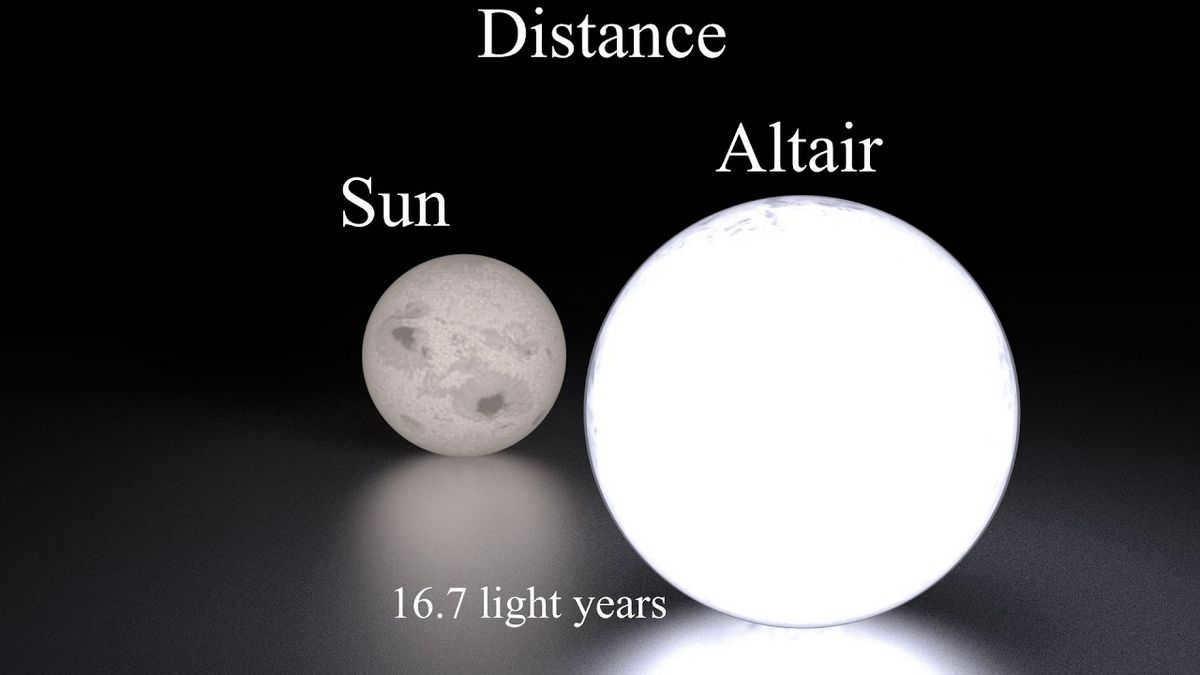

Altair is located in the constellation Aquila. It completes one rotation on its axis every 8.9 hours, causing significant distortion of its shape. The star’s equatorial diameter is 22% larger than its polar diameter. The star’s rapid rotation also leads to a decrease in physical parameters towards its center.
Altair has an absolute magnitude of 2.2 and an apparent magnitude of 0.77. The temperature near the poles is approximately 8000 K, but decreases to 6200 K as it approaches the equator.
Altair can be easily seen from Earth as one of the points of the summer-fall triangle. To locate this celestial object in the night sky, one can simply observe the sky shortly after sunset. It is one of the first stars to become visible.
Altair is situated in the constellation of Aquila and is the most prominent feature of this imaginary formation. Along with Tarazed and Alshain, it forms the asterism known as the Crown’s Scales.
The coordinates for Altair, the star in Aquila, are as follows:
The constellation containing Altair is positioned to the southwest of Cygnus.
What is the distance to Altair?
Altair is located at a distance of 16.73 light-years from Earth, equivalent to approximately 159 trillion kilometers. Furthermore, it is currently moving towards our solar system at a velocity of 26 kilometers per second.

Exploring the celestial body
Altair made its appearance in the starry sky over 5 thousand years ago. Its name originates from an Arabic phrase that translates to “eagle soaring”.
During the 1960s, astronomers conducted measurements to determine the star’s angular size. These measurements revealed that Altair is significantly flattened. In the year 2000, American astronomer G. van Belle made the first hypothesis that the temperature at the equator of this celestial object is lower than previously calculated.
The phenomenon of gravitational darkening was verified and analyzed after a span of 5 years using the VLT (also known as the Very Large Telescope), which comprises 8 instruments positioned at the Paranal Observatory in Chile. These investigations led to the classification of the star as a variable of the delta Shield type. Prior to these scientific inquiries, astronomers possessed no comprehension of the underlying cause behind its fluctuating luminosity.

Fascinating Trivia
In order to observe Altair directly through a telescope, a device with a mirror diameter of 300 meters is required. However, scientists were able to examine it by utilizing a clever combination of two telescopes within the VLT complex. Altair stands out as one of the rare celestial objects beyond our Solar System for which a detailed image of its disk has been obtained.
Aside from its notable distortion, another captivating aspect of this star for astronomers is its emission of low-level X-rays. The exact mechanisms behind this phenomenon have yet to be fully understood. The prevailing theory suggests that it may be attributed to the migration of matter from the poles towards the cooler equator.
Thanks to the use of advanced telescopes with high-resolution capabilities, astronomers have achieved a significant milestone – they have successfully conducted measurements on a star that is rotating at an incredible speed, resulting in its equator being pulled along. By employing the Palomar Interferometer, a collection of multiple telescopes, astronomers were able to calculate the star’s radius relative to its position in the sky. Surprisingly, they discovered that the star’s radius fluctuates in size depending on this specific parameter, providing concrete evidence of its non-spherical shape.
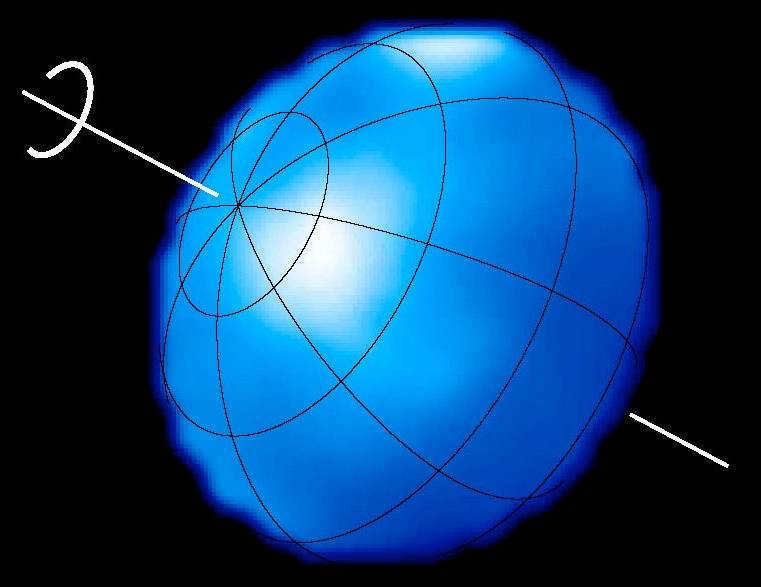
Altair is a star that is part of the A7IV-V class and is characterized by its hot, white appearance. It can be found in one of the points of the “summer-fall triangle” and is visible in the Northern Hemisphere during the autumn and summer seasons. It wasn’t until 2007 that an actual image of Altair was captured.
Distance and position
Altair is one of the closest stars to Earth, located at a distance of 16.8 light years or 5.14 parsecs. In terms of kilometers, this translates to approximately 159 trillion. Altair, along with Gamma Eagle and Beta Eagle, forms a well-known constellation of stars known as the Eagle Shaft or the Eagle Family.
This celestial body falls into the A class in the main sequence in terms of its spectrum, and it has a mass approximately 1.8 times that of the Sun, along with a luminosity 11 times greater than the Sun.
Related resources
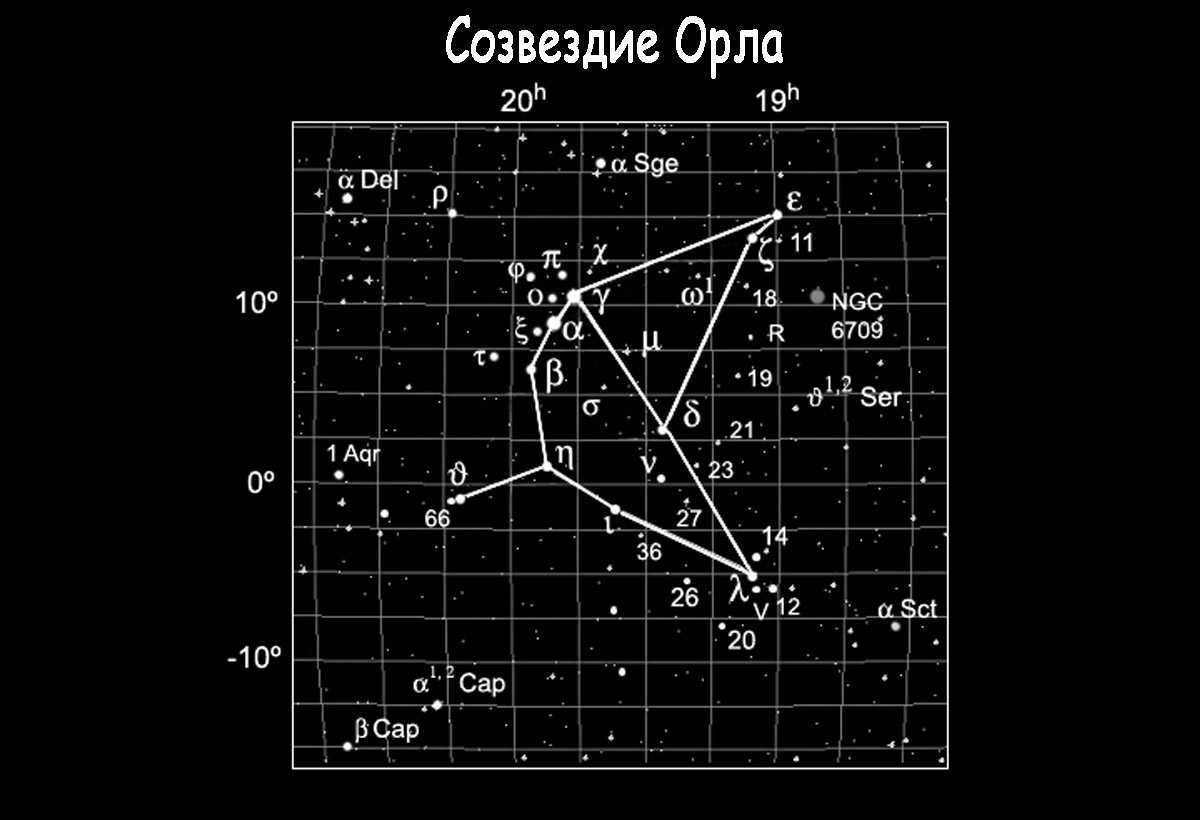
Altair is located in which constellation? It rotates rapidly around its axis, completing a full rotation in just 8.9 hours. Its speed is an impressive 286 km/s. In comparison, the Sun takes 25.05 days to complete a full circle, with an equatorial speed of 2 km/s. During rotation, Altair’s diameter is 22% larger in the equatorial region than in the polar region.
In 1999, the Wide Field Infrared Explore conducted satellite measurements, revealing that the luminosity of this nearby star varied slightly within a range of less than 0.001 magnitudes. Observations in 2005 classified the star as a Beta Shield type variable. Interferometric measurements carried out by Robert Brown and his team in the 1960s determined an angular diameter of 3 angular milliseconds. During this time, it was postulated by the same researchers that the star Altair would be significantly compressed due to its tremendous rotational velocity. However, the inability to accurately observe it prevented this hypothesis from being proven.
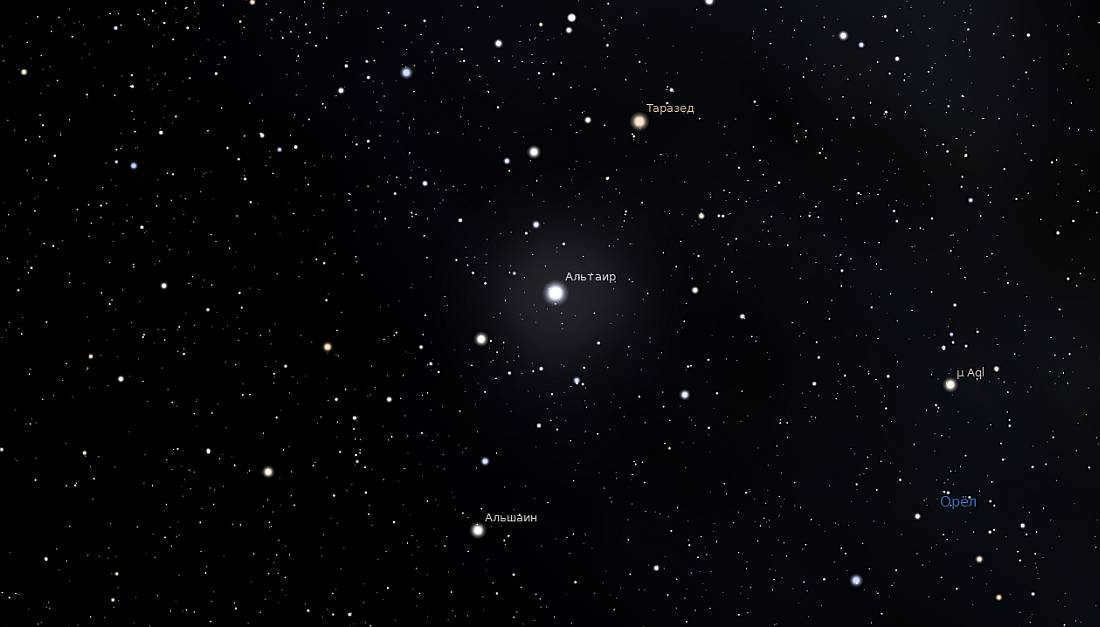
Screenshot from the planetarium program
In 1999 and 2000, Gerard van Belle and his colleagues conducted an investigation and proposed a hypothesis that Altair, due to its rapid rotation, exhibits lower surface gravity and equatorial temperature than expected. This phenomenon is known as gravitational darkening, where the star’s equator appears less bright. In 2005, Dominicano de Souza used VINCI instruments at VLT to study and measure gravitational darkening. Altair is one of the few stars for which we have been able to capture images of its disks. Just like the effect of surface compression, one can observe the gravitational darkening of Altair without much effort.
Comparison of models of the star’s surface with actual images
In order to observe the intricate details on the surface of this object, a telescope with a mirror diameter of 300 meters would be necessary. However, this parameter is currently unattainable. Nevertheless, astronomers have still been able to observe and study the star by utilizing multiple telescopes.
Compilation of the most luminous stars
| 0 | Sun | 0.0000158 | -26.72 | 4.8 | G2V | |
| 1 | Sirius (α of the Big Dog) | 8.6 | -1.46 | 1.4 | A1Vm | Southern |
| 2 | Canopus (α of Kiel) | 310 | -0.72 | -5.53 | A9II | South |
| 3 | Toliman (α Centauri) | 4.3 | -0.27 | 4.06 | G2V+K1V | South |
| 4 | Arcturus (α Volopas) | 34 | -0.04 | -0.3 | K1.5IIIp | North |
| 5 | Vega (α Lyra) | 25 | 0.03 (perm) | 0.6 | A0Va | North |
| 6 | Capella (α Ascendant) | 41 | 0.08 | -0.5 | G6III + G2III | North |
| 7 | Rigel (β Orion) | ~870 | 0.12 (perm) | -7 | B8Iae | South |
| 8 | Procyon (α of the Lesser Dog) | 11.4 | 0.38 | 2.6 | F5IV-V | North |
| 9 | Ahernar (α Eridanus) | 69 | 0.46 | -1.3 | B3Vnp | South |
| 10 | Betelgeuse (α Orion) | ~530 | 0.50 (perm) | -5.14 | M2Iab | North |
| 11 | Hadar (β Centauri) | ~400 | 0.61 (perm) | -4.4 | B1III | South |
| 12 | Altair (α Eagle) | 16 | 0.77 | 2.3 | A7Vn | Northern |
| 13 | Acrux (α of the Southern Cross) | ~330 | 0.79 | -4.6 | B0.5Iv + B1Vn | South |
| 14 | Aldebaran (α Taurus) | 60 | 0.85 (rem) | -0.3 | K5III | North |
| 15 | Antares (α Scorpio) | ~610 | 0.96 (perm) | -5.2 | M1.5Iab | South |
| 16 | Spica (α Virgo) | 250 | 0.98 (perm) | -3.2 | B1V | South |
| 17 | Pollux (β Gemini) | 40 | 1.14 | 0.7 | K0IIIb | Northern |
| 18 | Fomalhaut (α of South Pisces) | 22 | 1.16 | 2.0 | A3Va | Southern |
| 19 | Mimosa (β of Southern Cross) | ~290 | 1.25 (perm) | -4.7 | B0.5III | Southern |
| 20 | Deneb (α of the Swan) | ~1550 | 1.25 | -7.2 | A2Ia | Northern |
| 21 | Regulus (α Leo) | 69 | 1.35 | -0.3 | B7Vn | Northern |
| 22 | Adara (ε of the Great Dog) | ~400 | 1.50 | -4.8 | B2II | South |
| 23 | Castor (α Gemini) | 49 | 1.57 | 0.5 | A1V + A2V | Northern |
| 24 | Hakrux (γ Southern Cross) | 120 | 1.63 (perm) | -1.2 | M3.5III | South |
| 25 | Shaula (λ of Scorpio) | 330 | 1.63 (perm) | -3.5 | B1.5IV | Southern |





